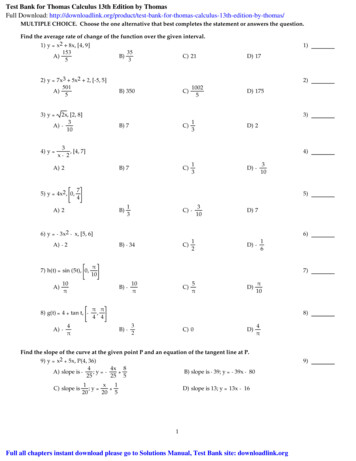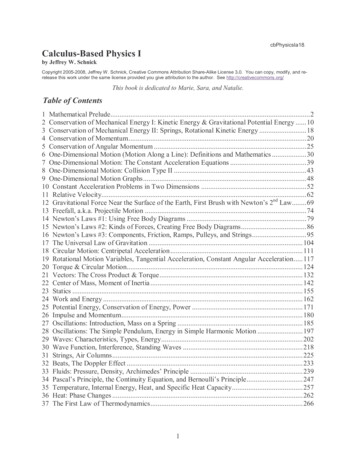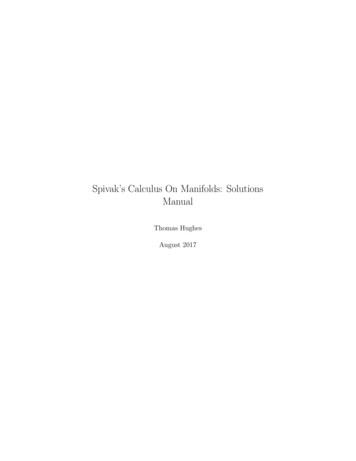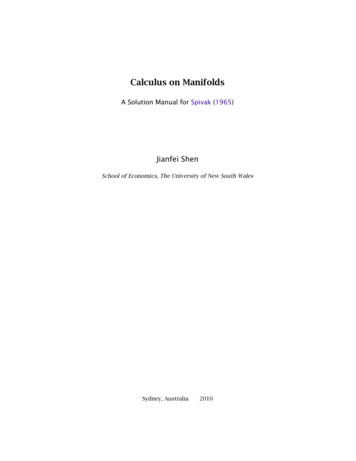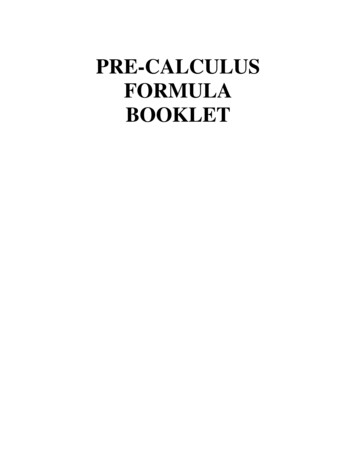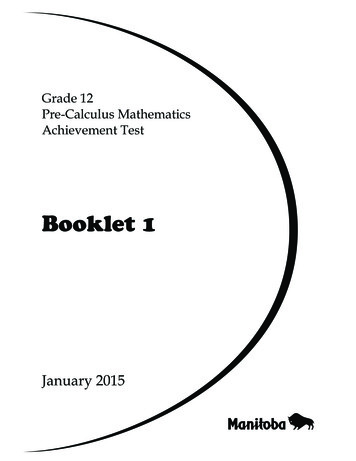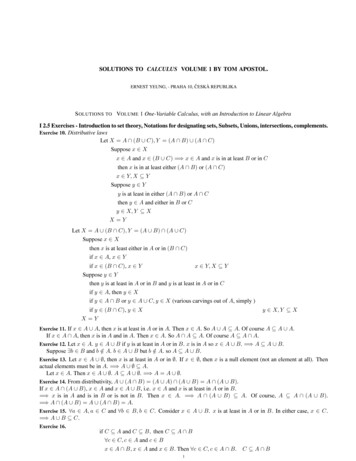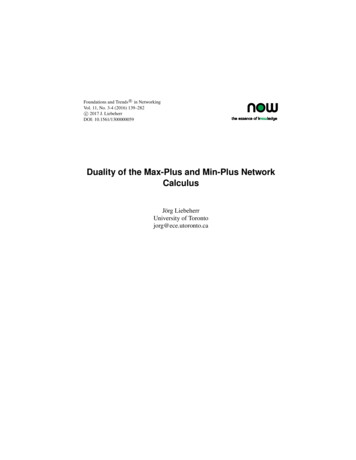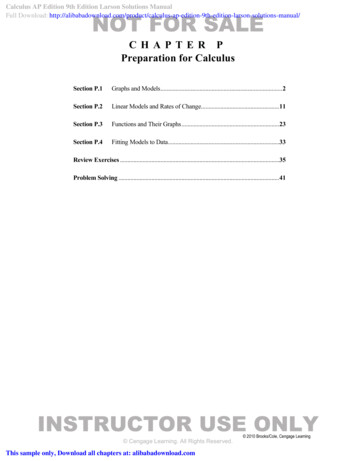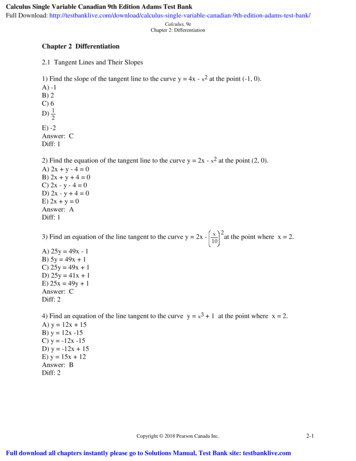
Transcription
Introduction to Calculus
Contents1 Introduction to Calculus1.1 Introduction . . . . . . . . . . . . . . . .1.1.1 Origin of Calculus . . . . . . . . .1.1.2 The Two Branches of Calculus . .1.2 Secant and Tangent Lines . . . . . . . .1.3 Limits . . . . . . . . . . . . . . . . . . .1.4 The Derivative . . . . . . . . . . . . . .1.4.1 Definition of the Derivative . . .1.4.2 Rules for Calculating Derivatives1.5 Applications of Derivatives . . . . . . . .1.5.1 Rates of Change . . . . . . . . .1.5.2 Tangent Lines . . . . . . . . . . .1.5.3 Graphing Polynomials . . . . . .1.5.4 Optimization . . . . . . . . . . .A Answers to All Exercises.33345101414161818222427312
Chapter 1Introduction to Calculus1.11.1.1IntroductionOrigin of CalculusThe development of Calculus by Isaac Newton (1642–1727) and GottfriedWilhelm Leibnitz (1646–1716) is one of the most important achievements inthe history of science and mathematics.Newton is without doubt one of the greatest mathematicians of all time.In his efforts to find a mathematical method that could explain universalgravitation, he devised what he called the method of fluxions. Today we callit differential and integral calculus.Newton was a private and secretive man, and for the most part kept hisdiscoveries for himself. He did not publish much, and the majority of hisworks, like his famous Philosophiae Naturalis Principia Mathematica, had tobe dragged out of him by the persistence of his friends.It is now well established that Newton and Leibnitz developed their ownform of calculus independently, that Newton was first by about 10 years butdid not publish, and that Leibnitz’s papers of 1684 and 1686 were the earliestpublications on the subject.If you are interested in finding out more about Newton and Leibnitz, orthe history of mathematics in general, consult the following y3
4CHAPTER 1. INTRODUCTION TO CALCULUS1.1.2The Two Branches of CalculusThere are two basic geometric problems that call for the use of calculus: Finding the slope of the tangent line to a curve at a given point. Finding the area between a curve and the x-axis for a x b.66.P.r. .R--abWhat is the slope of the tangent at P ? What is the area of the region R?We will examine the close relationship between the slope problem and theproblem of determining the rate at which a variable is changing as comparedto another variable. The portion of calculus concerned with this problemis called differential calculus. It relies on the concept of the derivative of afunction. You will eventually see that the derivative of a function is definedin terms of a more fundamental concept – the concept of a limit.The area problem is related to the problem of finding a variable quantitywhose rate of change is known. The part of calculus concerned with theseideas is called integral calculus and will not be covered here. It is studied infirst year calculus.
1.2. SECANT AND TANGENT LINES1.25Secant and Tangent LinesConsider two points P (x1 , y1 ) and Q(x2 , y2 ) on the graph of y f (x). Theline joining these two points is called a secant line and has a slope given bymP Q y2 y1.x2 x16y2y1. secant line.Q.t. . tangent line. . . . . .P.t. .-x1x2Figure 1.1: Secant line joining P and Q and tangent line at point P .If we let h x2 x1 , thenx2 x1 h and y2 f (x2 ) f (x1 h).The slope of the secant line joining P and Q is thenmP Q f (x1 h) f (x1 ).hLet’s now imagine that point Q slides along the curve towards point P .As it does so, the slope of the secant line joining P and Q will more closelyapproximate the slope of a tangent line to the curve at P . We can in factdefine the slope of the tangent line at point P as the limiting value of mP Qas point Q approaches P .As point Q approaches P , the value of h x2 x1 approaches zero. Theslope of the tangent line at P is thenf (x1 h) f (x1 )h 0hmtan lim
6CHAPTER 1. INTRODUCTION TO CALCULUSNote that we cannot evaluate the limitf (x1 h) f (x1 )h 0hlimby simply setting h 0 since this would lead to a fraction where both thenumerator and denominator are zero and we know that this is undefined.For a particular function f , we will be able to overcome this difficulty byusing algebra to factor an h from the numerator to cancel it with the h in thedenominator. The resulting limit can then be evaluated by setting h 0.Example 1. Consider the function f (x) x2 .(a) Compute the slope of the secant line joining the points (2, 4) and (3, 9).(b) Compute the slope of the secant line joining (2, 4) and (2 h, f (2 h))for h 6 0.(c) Compute the slope of the tangent line at the point (2, 4).(d) Sketch a graph of the function and the tangent line at x 2.Solution: The slope of the secant line joining the two points P (x1 , y1 ) andQ(x2 , y2 ) is given byy2 y1.(1.1)msec x 2 x1(a) Using (x1 , y1 ) (2, 4) and (x2 , y2 ) (3, 9) givesmsec 9 4 5.3 2(b) We use equation (1.1) with (x1 , y1 ) (2, 4) and (x2 , y2 ) (2 h, f (2 h))to getf (2 h) 4msec .(2 h) 2
1.2. SECANT AND TANGENT LINES7Since f (2 h) (2 h)2 , we have(2 h)2 4h(4 4h h2 ) 4 h4h h2 hh(4 h) h 4 h.msec (c) To find the slope of the tangent line to the graph of f (x) x2 at thepoint (2, 4), we usef (x1 h) f (x1 )h 0hwith x1 2. Since we found thatf (2 h) f (2) 4 h,hthenf (2 h) f (2)mtan limh 0h lim (4 h)mtan limh 0 4.The slope of the tangent line to the curve at x 2 is then equal to 4.(d) Here is a graph of y x2 and the tangent line at x 2.8642-3-2-10123
8CHAPTER 1. INTRODUCTION TO CALCULUSExample 2. Find the slope of a line tangent to y 2x2 5x at x 1.Solution: We usef (x h) f (x)h 0h2with x 1 and f (x) 2x 5x. Sincemtan limf (1 h) 2(1 h)2 5(1 h) and f (1) 2(1)2 5(1) 3,then2(1 h)2 5(1 h) ( 3)h 0h22(1 2h h ) 5 5h 3 limh 0h2 4h 2h2 5 5h 3 limh 0h22h h limh 0h lim (2h 1)mtan limh 0 1.The slope of the tangent line is then equal to 1.42-10123-2-4Figure 1.2: Graph y 2x2 5x and the tangent line at x 1.
1.2. SECANT AND TANGENT LINES9Exercises 1.21. Consider the function f (x) 2x2 1.(a) Compute the slope of the secant line joining the points (1, 3) and(2, 9).(b) Compute the slope of the secant line joining the points (1, 3) and(1 h, f (1 h)) for h 6 0.(c) Compute the slope of the tangent line at the point (1, 3).(d) Sketch a graph of the function and the tangent line at x 1.2. Find the slope of the tangent line to y f (x) at the indicated point.(a) f (x) 2x2 ,(3, 18).(b) f (x) 5x2 3x 2,(c) f (x) x3 ,(2, f (2)).( 2, f ( 2)). Hint: (a b)3 a3 3a2 b 3ab2 b3 .
10CHAPTER 1. INTRODUCTION TO CALCULUS1.3LimitsIn section 1.2, we computed limits without saying much about limits. Themethod we used doesn’t cover all possible cases. In this section, we will lookat limits in more detail.Let us consider the following piecewise-defined function(2x 1 if x 6 2,f (x) 3if x 2.This function is made up of two parts. One part is the line y 2x 1 withthe point (2, 5) deleted. The other part is the single point (2, 3).6.5b3r.2-Figure 1.3: Graph of the piecewise-defined function y f (x).As the values of x approach 2, the values of y f (x) approach 5, butf (x) can never be 5 since that is where the “hole” is. The number 5 is notin the range of f (x), but f (x) does have values which get arbitrarily close tothe value 5.xy f (x)1.9 1.99 1.999 1.9999 2 2.0001 2.001 2.01 2.14.8 4.98 4.998 4.9998 3 5.0002 5.002 5.02 5.2Table 1.1: Table of values for the piecewise-defined function y f (x).We then say that f (x) approaches the value 5 as x approaches 2, or thatthe limit of f (x) as x goes to 2 is equal to 5.
1.3. LIMITS11Symbolically we write this aslim f (x) 5.x 2Notice that it is not saying that f (2) 5 (in fact f (2) 3), it says that thevalues of f (x) approach 5 as x approaches 2.For a function f , the expressionlim f (x) Lx ameans that the values of the function f (x) approach the number L as thevalues of x approach a from both directions. Notice that we are not interestedin what happens at x a.If there is no number L that the function f approaches as x approachesa, then we say that the limit does not exist.For example, consider the function f (x) 1/x2 . As the values of xapproach 0, the values f (x) become arbitrarily large. Therefore1does not exist.x 0 x2limFor “well-behaved” functions (e.g. polynomials), we can evaluate limitsby direct substitution.Example 1. Consider the polynomial function p(x) 2x3 5x 1, then bydirect substitution we getlim p(x) lim (2x3 5x 1) 2(2)3 5(2) 1 7.x 2x 2x2 2x 1, by direct substitution we get3x 6x2 2x 132 2(3) 14lim f (x) lim .x 3x 33x 63(3) 615Example 2. For f (x) However, direct substitution does not always work and we will need tosimplify the expression before we can substitute.
12CHAPTER 1. INTRODUCTION TO CALCULUSExample 3. Evaluatex2 x 2.x 1x 1limSolution: If we substitute x 1, we get values of zero for both the numeratorand the denominator. We eliminate this problem by factoring the numerator.x2 x 2(x 1)(x 2)lim limx 1x 1x 1(x 1) lim (x 2)x 1 1 2 3.Example 4. Evaluate limx 3 x 3.x 3Solution: If we substitute x 3, we get values of zero for both the numeratorand the denominator. Rationalizing the numerator eliminates this problem. ! x 3x 3x 3 lim· limx 3x 3x 3x 3x 3(x 3) x 3 (x 3)( x 3)1 lim x 3x 31 3 31 .2 3 lim
1.3. LIMITS13Exercises 1.31. Consider(3x 1 if x 6 1,f (x) 2if x 1.(a) Sketch the graph of y f (x).(b) Compute lim f (x).x 0(c) Compute lim f (x).x 12. Consider f (x) x3 1.x 1(a) Complete the following table:xy f (x)0.99 0.999 1.001 1.01(b) Guess what lim f (x) is.x 1(c) Compute lim f (x) algebraically.x 13. Compute the following limits.2(a) lim (x 4x 1).x 33x3 4x.x 0 x2 xx2 2x 3(g) lim 2.x 1 3x 5x 2(d) limx2 5x 6(b) lim.x 2x 2x3 3x2 4(e) lim.x 1x 11 122 h(h) lim.h 0h x 2(c) lim.x 2x 2x2/3 4.(f) lim 1/3x 8 x 22x3 16(i) lim.x 2 x 2 4. True or False?x2 40(a) lim .x 2 x 20x2 4(b) If f (x) and g(x) x 2, then f (x) g(x).x 2x2 4(c) If f (x) and g(x) x 2, then lim f (x) lim g(x).x 2x 2x 2
141.41.4.1CHAPTER 1. INTRODUCTION TO CALCULUSThe DerivativeDefinition of the DerivativeFor the function f (x) x2 , the slope of the tangent line at x is different fordifferent choices of x. Indeed, the slope of the tangent line at an arbitrarypoint x, denoted here by mtan (x), isf (x h) f (x)h 0h2(x h) x2 limh 0h(x2 2xh h2 ) x2 limh 0h2xh h2 limh 0h lim (2x h)mtan (x) limh 0 2x.The tangent line at any point (x, y) on the graph of y x2 has a slope equalto 2x.For a function f , we call the function which gives the slopes of all tangentlines, the derivative of f . The derivative of x2 is then equal to 2x.Definition 1. The derivative of a function f at x, denoted by f 0 (x), isdefined byf (x h) f (x)f 0 (x) limh 0hprovided the limit exists. If the limit exists at x x0 , we say that thefunction f is differentiable at x0 .For a function y f (x), a number of notations are commonly used forthe derivative. They includef 0,f 0 (x),y0,y 0 (x),dy,dxdf,dxIt is a good idea to learn all these different notations.Dx f.
1.4. THE DERIVATIVE15Example 1. Compute the derivative f 0 (x) for f (x) x3 .Solution: Since f (x h) (x h)3 x3 3x2 h 3xh2 h3 , we havef (x h) f (x)h(x h)3 x3 limh 0h3(x 3x2 h 3xh2 h3 ) x3 limh 0h3x2 h 3xh2 h3 limh 0h2 lim (3x 3xh h2 )f 0 (x) limh 0h 02 3x .Thus, for f (x) x3 , f 0 (0) 0, f 0 (1) 3, f 0 ( 2) 12. Example 2. Find the derivative of f (x) x.Solution: We start as in the previous example.f (x h) f (x)h 0h x h x limh 0h x h xx h x· lim h 0hx h xh lim h 0 h( x h x)1 lim h 0x x h1 .2 xf 0 (x) lim Thus, for f (x) x, f 0 (4) 14 , f 0 (9) 61 , f 0 (10) 2 110 . Notice that f (x) x is defined at x 0 (f (0) 0) but the derivativedoes not exist at x 0. The derivative f 0 (x) is defined only if x 0. Forexample f 0 ( 5) is not defined.
16CHAPTER 1. INTRODUCTION TO CALCULUSExercises 1.4.11. Compute the derivative of the following functions by using the definition. No shortcuts!(a) f (x) 4x2 2x.(d) f (x) x4 .(b) f (x) 2x3 5. (e) f (x) x 1.1.xx(f) f (x) .x 1(c) f (x) 2. Given f (x) 1/(x 1), compute the derivative of f (x) at x 5,denoted by f 0 (5), using each of the following methods.(a) One-Step-Method: Substitute 5 for x in the formula of the derivative, i.e., use f (5) and f (5 h) rather than f (x) and f (x h).(b) Two-Step-Method: First determine f 0 (x) using the definition. Thenevaluate the derivative at x 5.3. On a graph of y f (x), what does f 0 (2) represent?1.4.2Rules for Calculating DerivativesWe will now provide a list of rules by which derivatives can
Chapter 1 Introduction to Calculus 1.1 Introduction 1.1.1 Origin of Calculus The development of Calculus by Isaac Newton (1642{1727) and Gottfried
